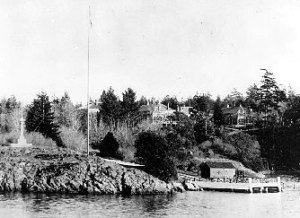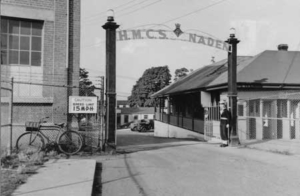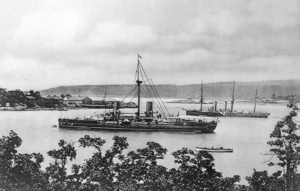History of
Naden at CFB Esquimalt
Towards the middle of the 19th century, concerns about Russian and American expansion resulted in the increased presence of British naval ships in the area. A hydrographic survey by HMS Pandora determined that Esquimalt Harbour’s narrow entrance and depth would make it an ideal location for a British naval port. The naval port at Esquimalt Harbour was christened in 1848, when British man-of-war HMS Constance, under Captain George William Courtenay’s command, dropped anchor in Esquimalt Harbour.
HMS Constance became the first British naval vessel based at Esquimalt.
The first shore facilities appeared as a result of the Crimean War (1854 – 1856). James Douglas, the Governor for Vancouver Island, was given a sum of money and instructions to have hospital huts built at the port. There were plans for a British attack on Russia, and the hospital facilities were intended for care of personnel who might be injured in the action. Accordingly, three wooden hospital huts were erected in 1855. Although no injuries resulted from the proposed attack on Russia, the Crimean huts, as the hospital buildings came to be known, were the first step towards establishment of a permanent shore facility.
The Royal Navy Establishment at Esquimalt was created in 1865 as an alternate base (or ‘station’) in the Pacific; the RN also had an operational base at Valparaiso, Chile.
Esquimalt grew increasingly strategic as a support base for the British navy in the Pacific. It was part of a worldwide network of coaling stations vital to the Royal Navy’s role of defending the British Empire around the globe. By 1887 Esquimalt had a drydock capable of holding the largest warship in the Pacific.
During the late nineteenth century, Britain’s naval presence in the Pacific dwindled steadily as the cost of maintaining a global fleet skyrocketed. The British could no longer afford the expense, and eventually made the decision to decommission Esquimalt and Halifax, their other North American naval base. Responsibility for its own maritime defence was handed over to Canada, and Britain’s Pacific command was formally terminated at sunset on March 1, 1905.
In 1910, the transfer of Esquimalt and Halifax to Canada was formalized when the Naval Service Act inaugurated the Naval Service for the Dominion of Canada.
NADEN Commissioned

Naden pictured towards the end of the 19th century. The cairn and cross to the left of the photo were erected in memory of four sailors from the British ship HMS WARSPITE who were lost in a canoeing accident off Vancouver Island. Photo Catalogue No. VR992.87.1
The Naval shore facility at Esquimalt was commissioned as HMCS NADEN on September 3, 1922. It was named for the facility’s Depot Ship, HMCS NADEN, a small wooden schooner built in 1913 that had previously been used for coastal surveys and cadet training.
As a Depot Ship, HMCS NADEN carried the books containing the names of the officers and men serving in the Esquimalt area. An old British Admiralty regulation required that all personnel working ashore must appear on the books of a naval vessel for purposes of pay and discipline, even when there was little real connection between base and ship.
When the Second World War began, NADEN become the principal Naval Training Centre for western Canada. The war years saw a rapid expansion of the facility to meet the huge demands of training the personnel needed for the war effort. During the war, the Royal Canadian Navy grew from just a dozen ships into the fourth largest Allied navy, comprising 100,000 personnel and 373 fighting ships.
Canadian Forces Base (CFB) Esquimalt came into being on April 1, 1966, as part of organizational changes which integrated the navy, army, and air force.





